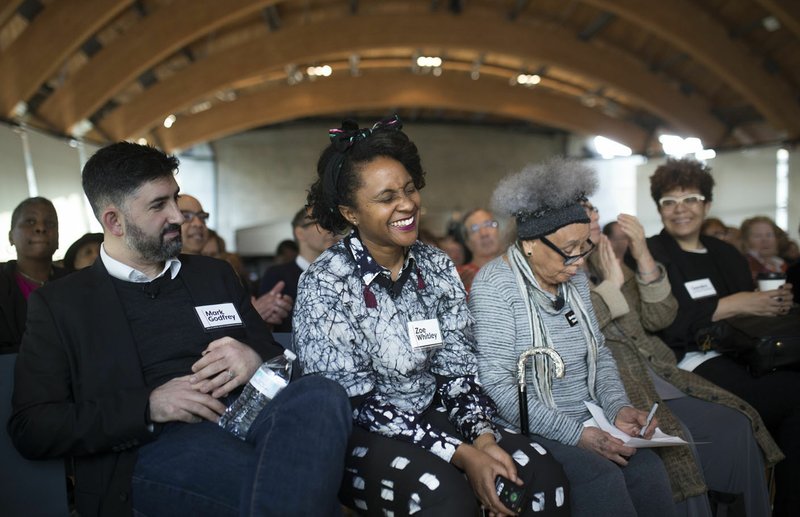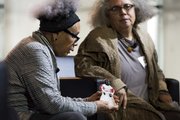BENTONVILLE — Guests began piling in more than an hour before Crystal Bridges’ regular 10 a.m. Saturday opening time, eagerly waiting to see and learn about its newest temporary exhibition “Soul of a Nation: Art in the Age of Black Power.”
Those fortunate enough to snag tickets to the sold-out symposium heard in person from many of the 60 artists whose 164 vibrant paintings, powerful murals, photographs, sculpture, and more are featured in the exhibition. Others tuned in via live-streaming for the event or just purchased a $10 ticket for the exhibit itself, now open to all.
The exhibition was developed by Tate Modern in London with Crystal Bridges Museum of American Art being the first of two U.S. stops. Following its time in Bentonville through April 23, the exhibition travels to the Brooklyn Museum in New York.
“Crystal Bridges welcomes this opportunity to introduce our visitors to artworks created by significant American artists at key moments in our nation’s history, and to tell a more expansive story of American culture,” said Rod Bigelow, Crystal Bridges executive director and chief diversity and inclusion officer. “We look forward to the much-anticipated U.S. debut of the exhibition, and to continuing the dialogue about the role of art in an ever-changing society.”
Tate Modern curators Mark Godfrey and Zoe Whitley opened the discussions by explaining the formation of the “Soul of a Nation” and their thought process.
The art reflects a variety of viewpoints of artists and collectives at work from 1963 to 1983. The layout of the exhibit is somewhat by date but also follows groupings of cities in the U.S. and different strategies the artist took, Godfrey said. For example, one room is called “Art on the Streets” and another “Black Heroes.”
While the work is framed by time and imbued with social and political history, Whitley said they worked to place focus on the art and aesthetic strategies.
“In no way are we trying to preserve in aspic this moment in the past. The reason why we are here today is because the artists are alive. We can look back, but we can also be here in this moment,” Whitley said, which is a sentiment echoed by of many of the artists themselves.
Mother and daughter artists Betye and Alison Saar spoke on, among many topics, on the ability and importance of re-purposing items in art to imbue them with new meaning.
One room in “Soul of a Nation” is dedicated to Betye Saar, whose work often focuses on mysticism, gender and race through multimedia collages, box assemblages and installations. This includes a mixed media assemblage, Gelede, 1971, recently acquired by Crystal Bridges.
She also reflected on what’s perhaps her most important piece, Liberation of Aunt Jemima, which started with her rage over the murder of Martin Luther King Jr., she said.
“That’s where I learned how to recycle within myself anger and emotions into a creative process,” she said.
Another room is devoted to the collective AfriCOBRA (African Commune of Bade Relevant Artist), based in Chicago in the late ’60s, four of whose founding members spoke at the symposium. The bright “Cool-Ade” colors — as the artists coined it — first stand out in the uniquely black aesthetic bolstered by a lively sense of rhythm.
Their first collaboration started with the black family, because “that’s the most threatened collaboration,” founder and clothing artist Jae Jarrell said. And they wanted to make their messages clear.
“The poster concept is rooted in our work, often times to steer you so you don’t necessarily read into our work your ideas but understand our ideas,” Jarrell said. “We very blatantly say a lot of things.”
Each of their works, as with any artist, also reflect their own experiences, though these experiences may be shared by many in the black community, as painter Gerald Williams shared.
His work Panthers and Pigs was inspired by his experience being stopped by a police officer while parking his car in his garage after work, because he “looked suspicious.” He was patted down while shivering without a jacket in about zero-degree weather, he said.
“My father had never seen me angry before. He said ‘It’s a good thing you got mad inside rather than out,’ because true to today, I might not be around,” Williams said. “Rage, I think, is a part of the war that exists inside of us.”
After viewing “Soul of a Nation,” the most common response from guests was a sense of being overwhelmed.
Anthony Freeman, a University of Arkansas at Little Rock architectural engineering student, said it’s a beautiful ugly.
“It’s like a mash-up of mixed emotions of anger, happiness, bitterness, sadness. It’s so expressive, I’m almost scared to view it, especially being African-American” Freeman said. “It’s not just art. It’s a reality of life. It’s all something we may want to forget or cover up, but it’s a reality and it still exists. Every artwork is a piece of that artist’s reality.”
The exhibition highlights key events, starting with the March on Washington in 1963, and considers cultural influences such as music, literature and sports, on the artists of the time, according to the museum’s description.
Some artists, galvanized by the spirit of the civil rights movement, created images of solidarity, strength and resistance, or paid homage to African-American figures such as Martin Luther King Jr., Malcolm X, and Angela Davis, musician John Coltrane, and sports hero Jack Johnson; while others focused primarily on color, form and concept.
“To see this in Arkansas, I never imagined,” visitor Victoria Mays said. “It’s just amazing.”
Mother and daughter visitors Brenda Yelvington and Kameron Morton said it’s incredible to see the exhibit in a state that has had a very complicated history with race. It’s ultimately a celebration of black people, art and history though some pieces can by painful, they said.
“Sometimes I think it’s really hard to look at another person’s pain,” Yelvington said. “It captures that human condition, and you just have to be willing to look. If you not willing, then it means you’re not willing to have compassion and see what part you play in it.”
‘Soul of a Nation’
The “Soul of a Nation” exhibition and symposium will be accompanied by programs including:
• Feb. 28: Spotlight Talk Panel: Discussion on African-American athletes in Arkansas. Evin Demirel will moderate a conversation around his book with guest speakers such as Razorback great and NBA and NCAA All-Star Sidney Moncrief.
• March 2: Performance Lab: The Last Poets perform a greatest-hits show from their spoken-word albums that inspired politically charged rap groups such as Public Enemy. The night will feature a vinyl signing.
• March 15, 22, 29: Listening Sessions: Music from the
1960s, ’70s, and ’80s, featuring selected tracks inspired by the temporary exhibition “Soul of a Nation: Art in the Age of Black Power.”
Other related resources:
• Soul of a Nation Spotify playlist, YouTube watch list and suggested readings is available online and in the print guide.
• Fully illustrated exhibition catalog in the museum store for purchase.
• Gallery interactives will
include videos showcasing speeches from prominent civil rights leaders, digitized Black Photographers Annual magazines, and clips of Just Above Midtown gallery performances.
• The museum restaurant, Eleven, will offer a Soul of a Nation tasting menu through March.
• Special tours through Soul of a Nation are planned for 1 p.m. on Mondays, Wednesdays, and Fridays for the run of the exhibition.
Source: Staff report
Ashton Eley can be reached by email at [email protected] or Twitter @NWAAshton.


